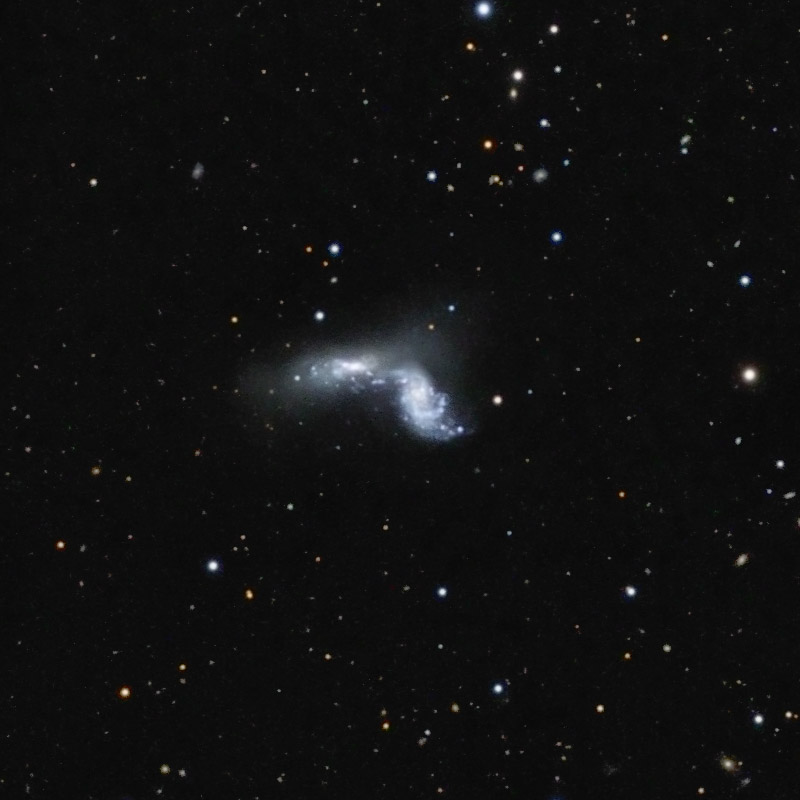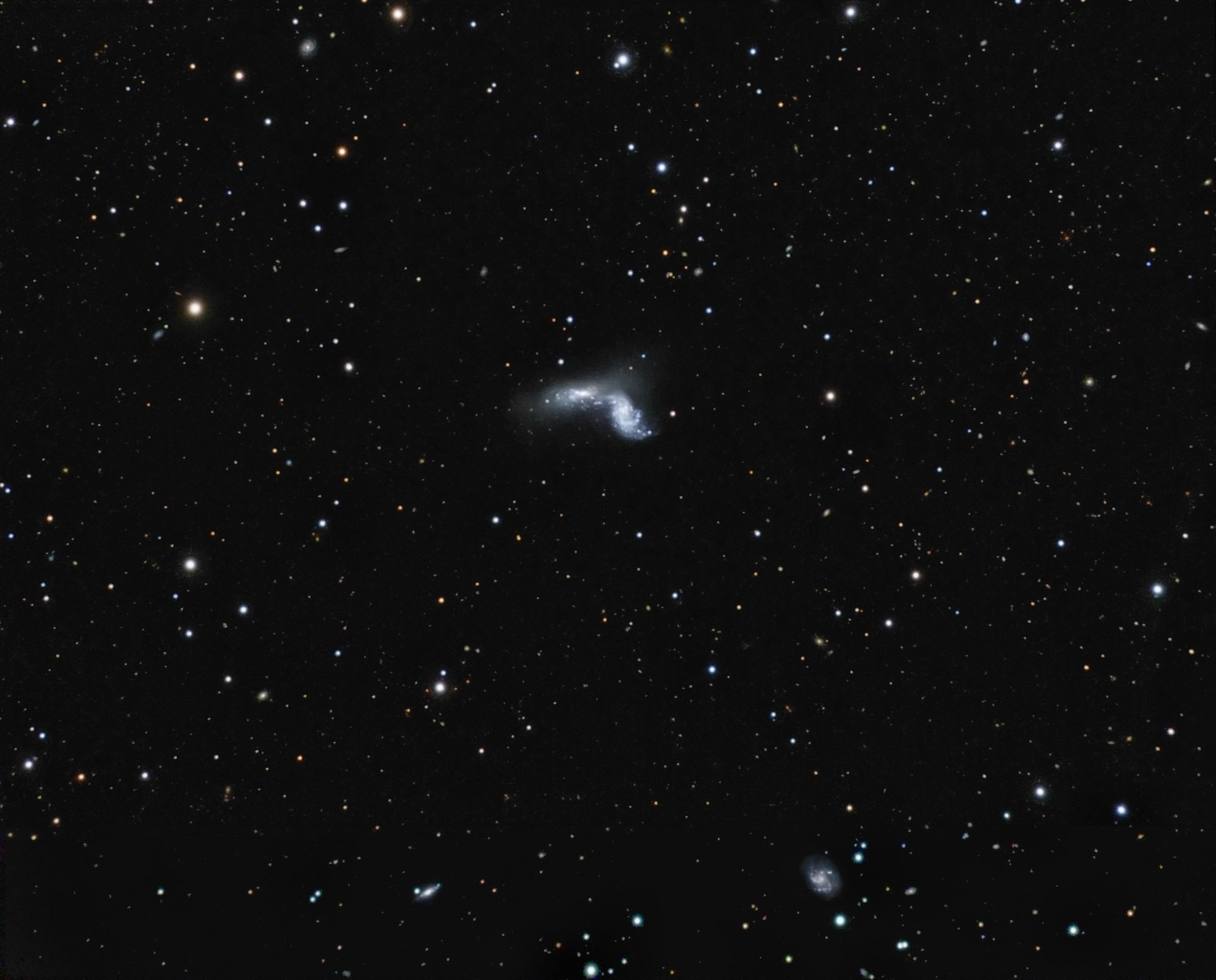Object name: ARP270Designation(s): ARP270, NGC3395, NGC3396, Arp 270 is a pair of NGC galaxies, NGC 3395 and NGC 3396. Both were discovered by William Herschel on the night of December 7, 1985. NGC 3395 was also discovered at a slightly different position by Stephane Javelle on May 13, 1896 which got it the IC 2613 designation. Only NGC 3395 made the original Herschel 400 observing program even though fainter than NGC 3396 with isn't in either. My notes from April 15, 1985 under humid conditions at up to 150x with my 10" F/5 reads: "Small, circular, puff of a galaxy just west of NGC 3396."
Several papers refer to NGC 3396 as being possibly disrupted by its companion. It is classed as a barred irregular galaxy. Though one paper claims it is SBm pec as they see hints of two arms. I found very few images of this pair on the net and those I did find didn't show the large spray of stars torn from NGC 3396, with the exception of the Sloan image which shows it to some extent. Arp's doesn't show it either. There is a dark region in this spray along the west side of NGC 3395. That is not a processing artifact. It was there to that extent in the original FITS data. It is hinted at in the Sloan image as well. I don't know what interaction could create this "shadow" but it is definitely real.
NGC 3995 is classed as midway between a normal spiral and a barred spiral having characteristics of both. I'm afraid I'm not seeing the barred characteristics in my image. They may be seen at other wavelengths such as radio. Arp's comment on it refers to the blue knots when he says: "Note arc form of emission knots."
Yet another paper classes both as Sc galaxies. It's nice to know galaxy classification is so easy to determine.
The spiral near the top of page left of center is SDSS J105030.39+330846.4, an IR galaxy indicating a lot of star birth is happening in it, is about 800 million light-years away and appear somewhat disturbed. This is easier to see if you double the size of the image.
The Zwicky galaxy cluster ZwCl 1046.0+3320 is near the right edge a bit above Arp 270. I see few galaxies right where its center is but a bit closer to Arp 270 there's quite a nice group clustered around a very red galaxy about 4 billion light-years away, SDSS J104852.82+330329.7. Many other apparent groupings exist in across the image but none were mentioned in NED.
Arp 270 is a member of a small group of galaxies all at about 90 light-years. Two of the others are at the very bottom of my image. They are IC 2604 and IC 2608. The oddly distorted spiral galaxy is IC 2604. It is classed as SBm pec. While the peculiar status is obvious with the two odd arms and a third that is mostly two star clouds, I don't see the bar that the "B" indicates. Sometime in the past, it appears to have had a near miss with one of the others in the group or ate one. Something sure tore it up. NED classes IC 2608 as a spiral. Looks like an SO to me.
You may note the dimensions of this image are unusual for me. That's because the first night I was imaging this group I was clouded out after only a few frames including 1 of each color. A few nights later I returned to it forgetting all about the two IC galaxies. So I centered Arp 270 and got some very good data just before dawn. That was last January. It wasn't until I went to process the image I realized I'd missed the two IC galaxies. So I salvaged the cloudy data as well as I could and tacked it onto the bottom of the main image. I had to crop the sides a bit as camera orientation had changed between the two images. I rarely remove the camera but did so between these two sessions, unfortunately. The bottom of the image is rather poor compared to the rest due to lack of data because of the clouds. They also created a horrid halo around the star at the very bottom. I was a bit heavy handed removing that glaring halo. When I realized what I'd done it was too late to go back and correct it.
In researching this one I came across a very good simulation of a galaxy merger of the type that is going on here. Back in the early 80's I used a 25Mhz computer with all of 4 megabytes of memory (cost $1000 a megabyte back then) to run galaxy collisions. It only could deal with about 10,000 points and took hours to calculate one simulation but showed it from three viewpoints which was nice. The only factors it considered was gravity and the motion vector of each point, which was considered to all be of the same mass. The simulation I found considers millions of points and takes into account many factors including dust and gas as well as the temperature of the dust and gas as well as how they affect the merger process. Obviously, they didn't use my ancient computer. The simulation is at: http://www.youtube.com/watch?v=agqLEbOFT2A
Arp's image:
http://ned.ipac.caltech.edu/level5/Arp/Figures/big_arp270.jpeg
Chandra image (X-ray) so shows mostly the hot gas heated by the collision:
http://chandra.harvard.edu/photo/2002/arp270/
Not imaged by Hubble that I could find. :(
My image data:
Main image 14" LX200R @ f/10, L=6x10' RB= 4x10' G 3x10',STL-11000XM, Paramount ME
Exposure for bottom part: L=3x10' RGB=1x10' through clouds Related Designation(s):1XMM J104955.3+325926, 2MASS J10495005+3258578, 2MASX J10495011+3258582, 2MASX J10495512+3259261, 2MASXi J1049499+325852, 2MASXi J1049558+325926, 2XMM J104949.8+325902, 2XMM J104955.3+325926, 2XMMp J104949.8+325902, 2XMMp J104955.3+325927, 7C 1047+3314, 87GB 104705.4+331522, 87GB[BWE91] 1047+3315, AKARI J1049498+325858, ARK 257, ARP 270, ARP 270 NED01, ARP 270 NED02, ARP 270:[BRP2005] H1, ARP 270:[BRP2005] H2, ARP270, ASK 516439.0, CG 0784, CG 0785, CGCG 1047.0+3314, CGCG 1047.1+3315, CGCG 184-018, CGCG 184-019, CXO J104955.0+325927, HDCE 0609 NED002, HDCE 0609 NED003, HOLM 215, HOLM 215A, HOLM 215B, IC 2613, IRAS 10470+3314, IRAS F10470+3315, KPG 249, KPG 249A, KPG 249B, KUG 1047+332, LDCE 0755 NED003, LDCE 0755 NED004, LGG 218:[G93] 002, LGG 218:[G93] 003, MCG +06-24-017, MCG +06-24-018, NGC 3395, NGC 3395:[LM2005] ULX01, NGC 3395:[RW2000] X-01, NGC 3396, NGC3395, NGC3396, NSA 090215, NVSS J104950+325855, NVSS J104955+325924, PGC 032424, PGC 032434, SDSS J104955.07+325926.9, SDSS J104955.08+325927.0, UGC 05931, UGC 05935, USGC U331 NED07, USGC U331 NED09, UZC J104950.1+325859, UZC J104955.2+325927, UZC-CG 122 NED02, UZC-CG 122 NED03, VV 246, VV 246a, VV 246b, [BEC2010] HRS 020, [M98j] 098 NED01, [M98j] 098 NED02, | | 
